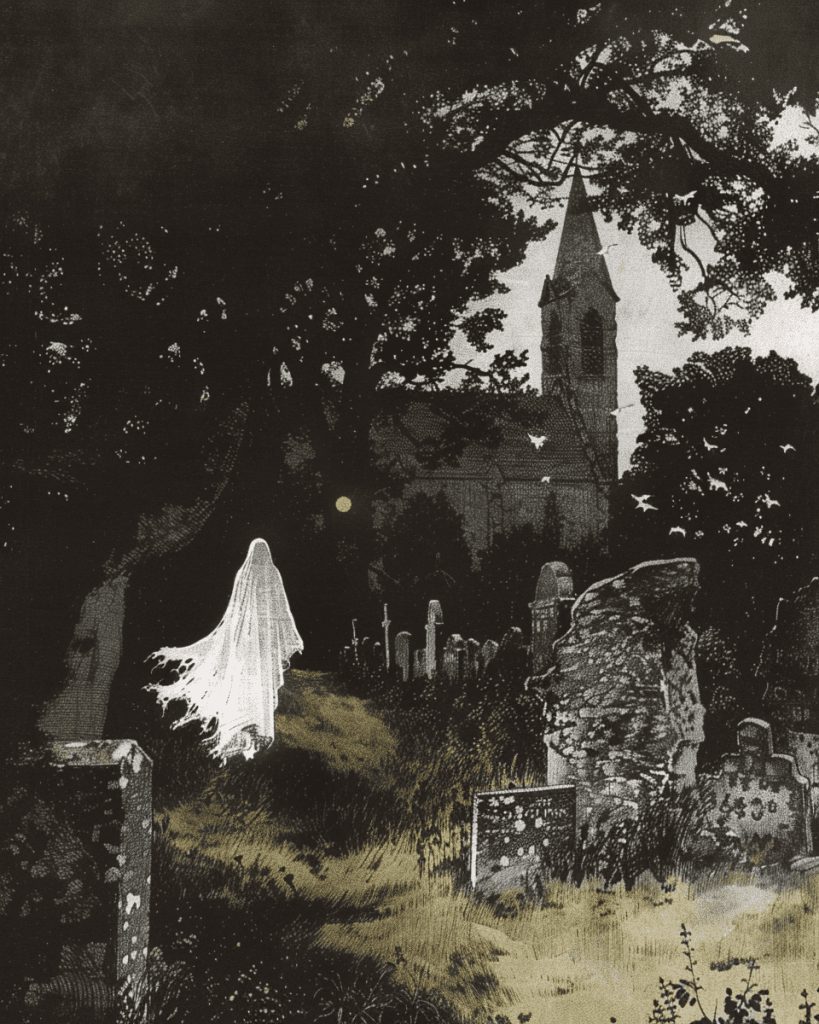The Hammersmith Ghost story is a fascinating tale of mystery and tragedy from early 19th century London.
In 1803, reports of a ghostly figure terrorizing the Hammersmith area began circulating. Locals claimed to have seen a spectral presence dressed in white, frightening passersby and even attacking some unfortunate souls.
As fear gripped the community, vigilantes took to the streets armed and ready to confront the apparition.
This heightened state of alarm led to a tragic incident on January 3, 1804, when Francis Smith, an excise officer, shot and killed Thomas Millwood, mistaking the innocent man for the ghost.
The case became known as the Hammersmith Ghost murder case and set a legal precedent regarding self-defense based on mistaken belief.
The ghost sightings continued even after this incident until a local shoemaker named John Graham confessed to being the prankster behind the haunting. He had dressed up in white sheets to scare his apprentice, unaware of the fear and chaos his actions had caused in the community.
Historical Background
The Hammersmith Ghost incident of 1804 occurred against a backdrop of superstition and social change in early 19th-century London.
Hammersmith in the 1800s
In the early 1800s, Hammersmith was a village on the outskirts of London. It was rapidly transitioning from a rural area to a more urban suburb.
The population was growing as people moved from central London seeking cheaper housing.
Hammersmith’s location a few miles west of central London made it an attractive area for development. New homes and businesses were being built to accommodate the influx of residents.
This period of change and growth created some social tensions.
Long-time rural residents found themselves living alongside city newcomers with different customs and beliefs.
Ghost Stories and Superstitions
Ghost stories and supernatural beliefs were very common in early 19th-century England. Many people firmly believed in the existence of ghosts, spirits, and other paranormal phenomena.
Sightings of ghosts were often reported and taken seriously by local communities. In Hammersmith, rumors of a ghost dressed in white began circulating in late 1803.
These ghost stories spread quickly and caused significant fear among residents.
Some people were afraid to go out at night. Others armed themselves for protection against supernatural threats.
The widespread belief in ghosts reflected the superstitious nature of society at the time. It also demonstrated how quickly rumors could spread in close-knit communities, sometimes with tragic consequences.
The Hammersmith Ghost Incident
In 1803-1804, a series of ghostly sightings in Hammersmith, London, led to panic and, ultimately, tragedy. The events culminated in a legal precedent regarding self-defense that would impact British law for centuries to come.
The Apparitions and Public Reaction
Reports of a ghostly figure began circulating in Hammersmith in November 1803.
Witnesses described encountering a tall, white apparition in the area’s churchyards and lanes. Some claimed the ghost attacked them, grabbing at their clothes or limbs.
As news spread, fear gripped the community.
Residents became reluctant to venture out after dark. Local authorities struggled to maintain order and calm the public’s nerves.
In response, some brave citizens formed ghost-hunting parties. They patrolled the streets at night, armed with various weapons. Their goal: to catch or confront the mysterious specter terrorizing their neighborhood.
The Tragic Mistake
On January 3, 1804, the ghost-hunting efforts took a deadly turn.
Francis Smith, a 29-year-old excise officer, was on patrol with his shotgun when he encountered a figure in white near Beaver Lane.
Believing he had found the ghost, Smith shouted a warning. When the figure didn’t respond, he fired.
Tragically, the “ghost” was actually Thomas Millwood, a local bricklayer wearing his white work clothes.
Millwood died from the gunshot wound. Smith, realizing his terrible mistake, immediately turned himself into authorities.
Aftermath and Legal Proceedings
Smith’s trial for Millwood’s death became a landmark case in British legal history.
Initially found guilty of murder and sentenced to death, Smith’s sentence was later commuted to one year of hard labor.
The case raised important questions about self-defense and mistaken belief. It established that a person could be held liable for their actions even if they resulted from a genuine but mistaken belief about a threat.
In the aftermath, the real “ghost” was revealed to be John Graham, a local shoemaker. He had been dressing in a white sheet to frighten his apprentice, unaware of the panic he had caused in the wider community.
Cultural Impact
The Hammersmith Ghost case left an indelible mark on British culture, influencing literature, art, and paranormal investigations. Its legacy continues to fascinate and inspire people to this day.
Literature and the Arts
The Hammersmith Ghost murder case captured the public imagination and found its way into various forms of artistic expression.
Authors and playwrights incorporated elements of the story into their works, using it as a backdrop for gothic tales and supernatural mysteries.
The case inspired numerous ghost stories and poems throughout the 19th century.
Some writers used the incident to explore themes of justice, mistaken identity, and the consequences of fear-driven actions.
Visual artists also drew inspiration from the ghost sightings, creating eerie illustrations and paintings that depicted the spectral figure haunting the streets of Hammersmith. These artworks helped solidify the ghost’s image in popular culture.
Paranormal Investigations and Folklore
The Hammersmith Ghost case sparked a renewed interest in paranormal investigations and ghost hunting.
Curious individuals and amateur sleuths flocked to the area, hoping to catch a glimpse of the infamous specter.
Local folklore embraced the ghost story, with residents passing down tales of encounters and sightings through generations.
The ghost became a part of Hammersmith’s identity, attracting tourists and paranormal enthusiasts to the neighborhood.
The case influenced the development of ghost-hunting techniques and equipment.
Investigators began using more sophisticated methods to document and analyze alleged supernatural phenomena.
The Hammersmith Ghost’s legacy persisted well into the 19th century, with sightings reported until the 1830s.
It paved the way for other famous ghostly figures in British folklore, such as Spring-heeled Jack.

